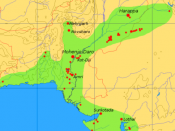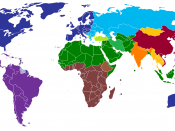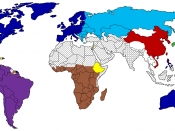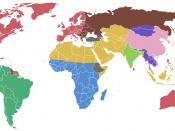After the rise of agriculture in the Neolithic era, four major civilizations developed in different parts of the world. They existed in Mesopotamia, Egypt, Indus Valley and China. The ones that endured the longest to a lesser degree was Egypt, but to a much larger degree, China, which kept its civilization in existence straight into the modern era. This was due to their agriculture, united government, military defense, writing system and ability to embrace outside influences.
The Egyptians had a centralized government, fertile lands and isolated culture whereas the people of Mesopotamia had regional city-states, aggressive culture, rough climate, few natural barriers and suffered constant attacks from nomads .1 However, both eventually declined. Also, the Indus Valley civilization was destroyed and failed to leave behind its fundamental patterns of civilized life. One factor to its decline was an inability to adapt to nomadic cultures. However, on a vastly larger scale, China has proven it has the worldÃÂs longest lasting civilization, enduring into the present day.
2Various major factors played a vital role in the longevity of China. Stearns identifies in his book, ÃÂWorld CivilizationsÃÂ how ChinaÃÂs access to rivers along with agriculture contributed to advanced technology and states, ÃÂShang irrigation and dike systems and millet and wheat cultivation provided the basis for the innovations and expansion of subsequent dynasties.ÃÂ 3He also explains how the Chinese sense of unity and beliefs contributed to their strong political system, ÃÂThe concept of the Mandate of Heaven has been pivotal in Chinese political thinking and organization.ÃÂ 4 Their strong government enabled them to endure even during periods of crises over the course of centuries. Additionally, the Loess regions of northern China began to create military technology to protect themselves from nomadic raids. People from the north kept moving towards the central areas of Chinese civilization and because there was a strong sense of identity amongst cultivating people, they united under strong leadership against others who didnÃÂt embrace the Chinese culture. 5He further explains how writing played a key role in communication between the elite class and the rest of the people. ÃÂThe scholar-bureaucrats, who developed this written language and also profited the most from it, soon emerged as the dominant force in Chinese culture and society. Chinese characters provided the basis for the educational system and bureaucracy that were to hold Chinese civilization together though thousands of years of invasions and political crises.ÃÂ 6On the contrary, constant interaction with nomads from the outside enriched the Chinese culture and made it more open to outside influences, social structures and political systems. 7In conclusion, agriculture, united government, military defense, a writing system and ability to embrace outside cultures, social structures and political systems enabled ChinaÃÂs civilization to surpass those of Mesopotamia, Egypt and Indus Valley and remain in existence into the present day.
Works Cited1.Peter Stearns et al., World Civilizations, 5th ed. (New York: Pearson Education, 2008), 27-442.Peter Stearns et al., World Civilizations, 5th ed. (New York: Pearson Education, 2008), 603.Peter Stearns et al., World Civilizations, 5th ed. (New York: Pearson Education, 2008), 614.Peter Stearns et al., World Civilizations, 5th ed. (New York: Pearson Education, 2008), 615.Peter Stearns et al., World Civilizations, 5th ed. (New York: Pearson Education, 2008), 616.Peter Stearns et al., World Civilizations, 5th ed. (New York: Pearson Education, 2008), 617.Peter Stearns et al., World Civilizations, 5th ed. (New York: Pearson Education, 2008), 61





